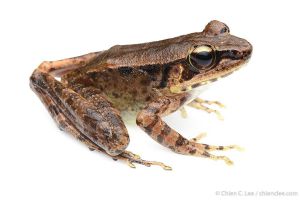
Frogs of Borneo

Frogs of Borneo

Frogs of Borneo

Frogs of Borneo

Frogs of Borneo

Frogs of Borneo

Frogs of Borneo

Frogs of Borneo

Frogs of Borneo

Frogs of Borneo

Frogs of Borneo
dyscritus
Liwagu Torrent Frog
Meristogenys discrytus inhabits clear mountain streams and is known from Gunung Kinabalus and Crocker range, between 500 to 1500 m a.s.l.
Meristogeny dyscritus is very similar in appearance to M. amoropalamus; so much so that the original description considered them cryptic species. See page of M. amoropalamus for comparison. In females, M. dyscritus have longer hands (usually longer than 31% of SVL) than M. amoropalamus (usually less than 31% of SVL). Males of M. amoropalamus usually have larger eardrums (more than 13 mm 2) than those of M. dyscritus (less than 15 mm2), however, there is overlap. In the field, elevation and the upper iris coloration may help to make a tentative assessment.
Males reach 32–40 mm and females 61–71 mm in snout-vent length (SVL). The iris is sandy brown colored above and dark red below. The rear side of the thigh is dark with dusted light spots. The feet are not fully webbed: at the fourth toe the terminal two finger segments are free of broad webbing.
The backside is brown with scattered dark spots. There is a dark streak from the eye to the snout, just below an edge (canthus). A dark band starts behind the eyes and continues along the upper flank; branching off from the band is another dark streak that goes down behind the eardrum.
Examination of gravid females showed that this species may produce 700–1500 eggs.
Tadpoles are adapted to clear cascading mountain streams and possess an abdominal sucker and divided upper and lower jaws. Contrary to the adult morphology, the larvae of M. dyscritus differ from those of M. amoropalamus morphologically. The larvae of M. dyscritus have six rows on upper keratodont rows, while those of M. amoropalamus have seven. At young developmental stages, the lower jaw sheaths of both larvae are divided, but only those of M. amoropalamus fuse into a large single jaw sheath before metamorphosis. Glands in a tail are limited to the ventral fin in larval M. dyscritus, while they are present in both fins of larval M. amoropalamus.
Version tracking
-
14.08.2025
updated
